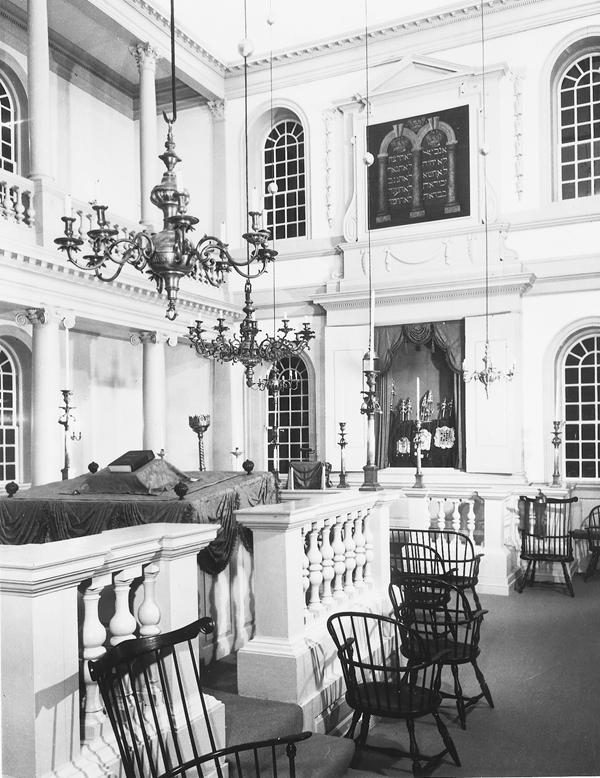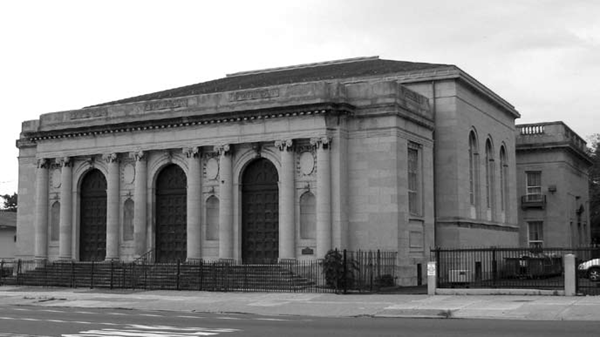The history of Jewish communities in the United States can be traced as far back as colonial communities, when the first Jewish settlers arrived in Virginia in the 17th century. In celebration of this long heritage and Jewish American Heritage Month, we’ve put together a glimpse of some of United States’ most historically significant synagogues and Jewish congregations.
Touro Synagogue: Oldest Synagogue in the United States

The oldest standing synagogue in America, the Touro Synagogue broke ground in 1759 in Newport, Rhode Island. Designed by British architect Peter Harrison, the synagogue was built for Congregation Jeshuat Israel and was formally dedicated in December of 1763. It is the only synagogue to survive from the colonial era, and is still serves as an active Orthodox congregation. The synagogue is also home to a letter from President George Washington, sent to the synagogue warden in 1790. The letter, which speaks on the importance of religious pluralism and freedom, is recited yearly by influential speakers; recent examples include Supreme Court Justices Ruth Bader Ginsberg and Elena Kagan.
Kahal Kadosh Beth Elohim: Oldest Synagogue in Continuous Use in the United States

Located in Charleston, South Carolina, the Kahal Kadosh Beth Elohim synagogue is the second-oldest in the country, and the oldest synagogue in continuous use. Built in 1840, the synagogue is home to Congregation Beth Elohim, one of the oldest Jewish congregations in the United States, founded in 1749. The congregation is often cited as the home of Reform Judaism in the US, after a group of liberal congregants left (and subsequently rejoined) the old congregation due to a difference in theological principles. Many of these principles (such as a more conceptual approach to the Torah, and a less strict approach to rituals) can still be seen in modern-day Reform Judaism.
Mikveh Israel: One of the Oldest Congregations in Philadelphia

Founded in the 1740s in Philadelphia, Congregation Mikveh Israel is one of the oldest congregations in Philadelphia, and was started by Spanish and Portuguese immigrants. The congregation, which still practices in the Spanish and Portuguese rite with a weekly Shabbat service, is also home to the second-oldest surviving Jewish cemetery in the United States. This cemetery was started by Nathan Levy, who was said to have transported the Liberty Bell on his ship the Myrtilla. Intended as a burial ground for the entire Jewish community of Philadelphia, the cemetery came under the care of the congregation in 1765. Today, the cemetery is registered on the National Register of Historic Places.
Sherith Israel: Established During the California Gold Rush
One of the oldest synagogues in the country, Sherith Israel was established during the California Gold Rush in San Francisco, CA. A member of Reform Judaism, the congregation is recognized for its innovative approaches to worship, including welcoming interfaith couples and a congregation-wide focus on social justice.
The synagogue is also well-known for its sanctuary building, which was constructed in 1905 in response to nearly outgrowing the original Gothic Revival-style synagogue. The sanctuary features many Judaic frescoes, which depict classic Judaic symbols like the Ten Commandments, the Torah, and a Chanukah menorah. Since surviving the 1906 San Francisco earthquake with only moderate damage (and no damage during the 1989 Loma Prieta earthquake), the synagogue has become a popular tourist destination for architecture enthusiasts, and has been on the National Register of Historic Places since 2012.
Mickve Israel: Only US Congregation to Practice in Gothic-Style Synagogue
Organized in 1735 by Spanish-Portuguese Jews, Congreagation Mickve Israel is among the oldest congregations in the nation, and the only to practice in a Gothic-style synagogue. Located in Savannah, Georgia, the synagogue was consecrated in 1878, and is the latter of two worship sites for the congregation. Like the Touro Synagogue, Congregation Mickve Israel is also home to a letter from President George Washington, which was sent shortly after his election to the Presidency. This letter was the first sent by the President to a Jewish community, and was sent after the congregation congratulated him on his election. The letter asks that God continue to bless all those who practiced within an Abrahamic religion.
Lloyd Street Synagogue: First Synagogue in Maryland
The first synagogue erected in Maryland and the third oldest synagogue in the country, the Lloyd Street Synagogue has had several uses since its construction. Built in 1830, the synagogue was first home to the Baltimore Hebrew Congregation, and was designed by architect Robert Cary Long, Jr.. Long, who was also responsible for the construction of St. Peter the Apostle Church in Baltimore, designed the buildings as near-twins of one another. The synagogue building was subsequently sold by the congregation in 1889 to a Catholic parish, which occupied the building until 1905, when it was sold back to an Orthodox Jewish congregation. Saved from demolition in by the newly created Jewish Historical Society of Maryland, the synagogue now operates as the Jewish Museum of Maryland, and serves as a museum on Jewish history.
Sixth and I Historic Synagogue: Non-Traditional Worship Site in Washington, D.C.
Constructed by the Adas Israel Congregation in 1908, the Sixth and I Historic Synagogue is a non-traditional worship site located in Washington D.C. The synagogue is both non-denominational and non-membership, and offers services to all Jewish denominations, with six unique sets of prayer books to properly represent all of these denominations. The synagogue’s non-traditional approach to worship came after it was saved from being transitioned into a nightclub in the early 21st century by three Jewish developers. After the building was restored and rededicated in 2004, it became home to not only its unique services, but also larger public outreach events. These events have included talks with major figures like President George W. Bush and Elie Wiesel, concerts, and even comedians.
Rodeph Shalom: Oldest Ashkenazic Synagogue in the Western Hemisphere

The oldest Ashkenazic synagogue in the Western Hemisphere, Congregation Rodeph Shalom was founded in 1795 in Philadelphia, Pennsylvania by immigrants from Germany, Holland, and Poland. The first synagogue in Pennsylvania to receive a corporate charter, the congregation is known not only as a leader in the Reform Judaism movement, but also as one of the only Byzantine-Moorish style synagogues in the country. Their current synagogue, which was built on the site of the first worship site, was built in response to outgrowing the original building. The synagogue has maintained a historically significant presence, and hosted President Barack Obama during the 2008 Passover.
Visit arcadiapublishing.com to learn more about religious buildings in the US.

